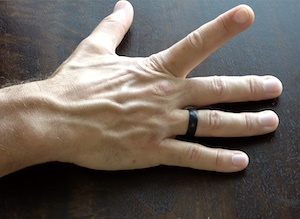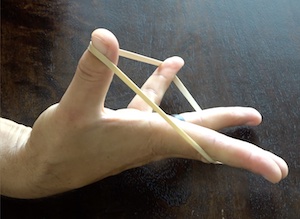We all want a strong grip. But if you’re not careful, you can end up with a weaker grip due to a “trigger finger”.
That’s what happened to me. Don’t let it happen to you!
If the video won’t play, click this link. Transcript below. Happy training!
Tip for a Strong Grip
TRANSCRIPT
Howdy! Ando here from HLMA. Today, I’ve got a tip to help you build a strong grip. But first, let me give you a warning. As you can see, I’ve had a problem with my hand lately. The cause?
Too much squeezing my hand and not enough extending it.
It’s called trigger finger. Now, I’m not a doctor, but I can tell you that my trigger finger was basically an overuse injury. Maybe you can relate.
If you’re a martial artist, you probably spend a lot of time punching, grabbing, swinging sticks and staffs, maybe messing around with weights and battle ropes, but let me ask you—how much time do you spend extending and stretching your fingers?
Well, if you keep squeezing your hand all the time, you can develop a nodule. It’s just like a callous, but instead of being on the outside, it’s on the inside, on your tendons. If that nodule gets too big, it gets stuck, which means your finger gets stuck. Which sucks! So what can you do when that happens?
First, I tried resting it for a couple weeks. Didn’t work. Then I tried wearing a splint for a couple months—even when I slept. Didn’t work. I tried ice, heat, massage, two cortisone shots, swearing, and jabbing it with a pen—didn’t work.
No joke—for a year and a half, I was unable to make a solid fist or play the violin. To be fair, I don’t own a violin, but what if I wanted to?
Ultimately, I had to say yes to a little surgery, which believe me, is a real pain in the hand. And I don’t want that to happen to you, so if you want a strong grip, here’s my advice.
1) Listen to your body.
I have a confession. For months before my finger locked up, I would wake up in the middle of the night with stiff hands. I figured it was just arthritis because I’m getting old, but it was actually overuse. My body was telling me to let my hands rest, but I didn’t want to hear that. I wanted to train.
Don’t make that mistake! Whether you’re learning a new skill or grinding away at an old skill, always give your body time to adapt, heal, and recover. Your body is talking to you through fatigue, soreness, and pain. Listen to it.
2) Balance your training.
I have another confession—I am guilty of ignoring my own advice. You might have seen a video I made years ago about a shoulder injury. The cause? Too much pushing and not enough pulling.
You can find that video here:
Tips for Shoulder Flexibility.
Oops—I did it again! Yes, I still believe in strengthening your grip by flexing and squeezing your fingers closed, but I also believe in extending and stretching your fingers open. So, here are some quick ideas to help you balance out your training for a strong grip.

Finger lifts. Leave your hand flat on a table and lift your fingers one at a time. Like playing a piano upside down.
Finger flicks. Pretend to send a spitball across the room with each finger.
Finger drags. Touch your fingertips together on a table or your leg, then just slowly drag them across the surface until your fingers are extended.
Rubber bands. Wrap a rubber band or two around your fingers and just play with it.
Passive stretches. Relax your hand and slowly push your fingers back. It should feel good!

It’s not complex—just open your hand!
Now, you might be wondering how many reps? How many sets? How many days of the week? To answer that, let me give you the answer a physical therapist gave me when I was rehabbing my shoulder—one for one.
Yup. Each push should be paired with a pull. Each flexion should be paired with an extension. One for one.
Okay. Another confession… I didn’t do that and there’s no way I’m ever going to do that! I mean, if I’m punching a heavy bag, I’m not gonna count how many times I squeeze my fist and then stand there for another round stretching a rubber band the same number of times.
But what I AM going to do, and what I recommend that YOU do, is whatever you can whenever you can. What does that mean?
It means that now you’re aware that an imbalance in your training can lead you to serious problems, so any effort you make to balance your training is better than no effort.
Maybe you focus on hitting the heavy bag when you’re at the gym, but focus on stretching your fingers when you’re on the couch watching TV. Or maybe if you spend a lot of time curled up in a defensive crouch or in a turtle position, you also spend some time opening your shoulders and expanding your chest when you’re in the car or stand around waiting in line. The point is this—
Be aware of what you’re asking your body to do and make time to do the opposite, too.
Man, I love a good rhyme. Or a bad one. Anyway, listen to your body and balance your training.
Push/pull. Flex/extend. Train/rest. Take/give.
That’s a smart way to live—physically and spiritually. If you liked this video, thanks for sharing with someone who needs to hear it. Until next time, consider taking a violin lesson, my friend, and keep fighting for a happy life.
